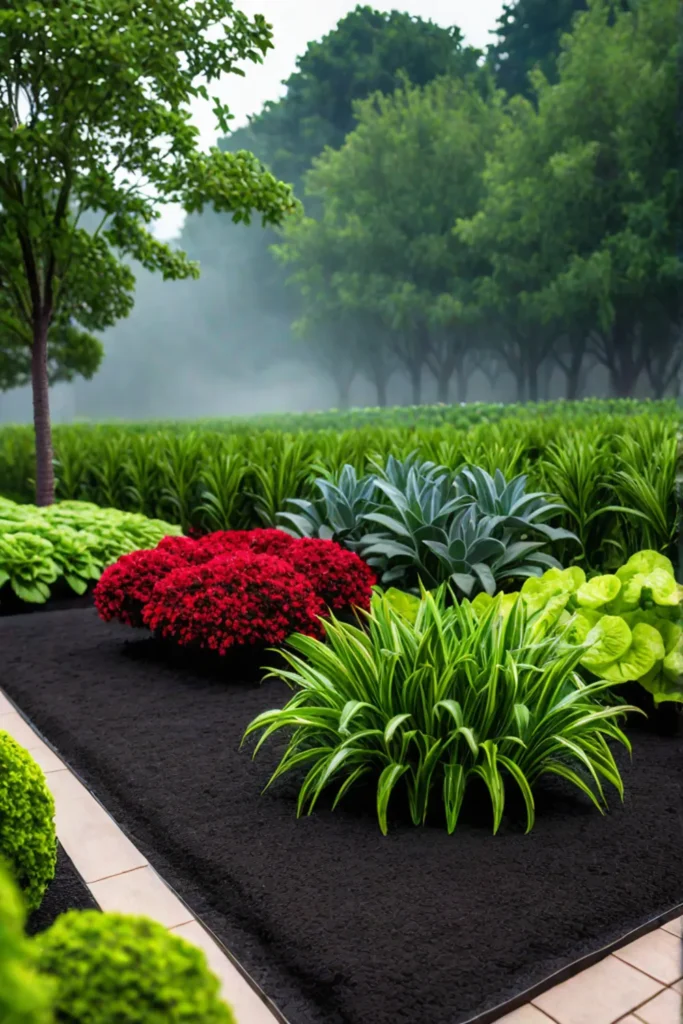As a home decorator and handyman, I know firsthand how rewarding and fulfilling it can be to grow your vegetables. But I also remember how intimidating it felt when I first started. I’m excited to share the ten best vegetable garden ideas for beginners like you.
Whether you have a small backyard or a larger plot of land, these ideas will help you create a thriving and productive vegetable garden. You’ll be able to enjoy fresh, homegrown produce all season long – without feeling overwhelmed.
So, let’s dive in and explore these simple yet effective vegetable gardening techniques. By the end, you’ll be on your way to becoming a confident and successful vegetable gardener.
Raised Garden Beds
One of my favorite options for beginner gardeners is raised garden beds. These elevated planting areas offer several key advantages.
First, they allow you to have better control over the soil quality. You can fill the beds with a nutrient-rich mix that’s perfect for growing vegetables, helping ensure your plants get the nourishment they need to thrive.
Raised beds also have great drainage, which helps prevent waterlogging and root rot. And since they’re raised off the ground, they’re easier to access and maintain – no more bending or kneeling required!

Another bonus? Raised beds can extend your growing season. The soil in these beds warms up faster in the spring, letting you start planting earlier.
Construct a frame using rot-resistant wood, like cedar or redwood, to build a simple raised garden bed. Then, fill it with a high-quality soil blend. It’s a straightforward project that can make a big difference in your veggie patch.
Container Gardening
Container gardening is a fantastic option for those with limited outdoor space. You can grow vegetables in pots, planters, or even repurposed containers like barrels or buckets.
The beauty of container gardening is that it’s endlessly customizable. You can place the containers on your patio, balcony, or sunny windowsill. And since the plants are in portable containers, you can easily move them around to find the perfect spot.
When it comes to container gardening, choosing the right size and type of container is key. Tomatoes, for example, need a deep pot to accommodate their root systems. Herbs and leafy greens, on the other hand, can thrive in smaller containers.

Regardless of what you’re growing, use a high-quality, well-draining potting mix. This will help prevent waterlogging and ensure your plants get the necessary nutrients.
With creativity and the right container setup, you can enjoy a bountiful harvest even in the smallest spaces. It’s a great way for a beginner to dip your toes into vegetable gardening.
Vertical Gardening
If you’re short on square footage, vertical gardening is a game-changer. This space-saving technique allows you to grow various veggies upwards rather than outwards.
Vertical gardens can take many forms, from simple trellises and cages to elaborate tower systems. The key is to select well-suited plants for vertical growth, like cucumbers, pole beans, and tomatoes.
One of the biggest benefits of vertical gardening is that it can boost your yields by up to 300% compared to traditional row planting. That’s because you’re making the most of your available space and allowing plants to grow up instead of out.

Vertical gardening also makes it easier to tend to your plants and harvest your crops. No more bending and stooping is required!
You can build a simple vertical structure using wooden posts and wire or netting to get started. Then, choose your climbing veggies and get them planted. It’s a clever way to maximize your gardening space, even in tight quarters.
Companion Planting
One of my favorite vegetable gardening techniques is companion planting. This involves strategically pairing different plants together to create a mutually beneficial relationship.
For example, did you know planting marigolds near your tomatoes can help deter pests? Or can growing beans alongside your corn improve the soil’s fertility?
Companion planting is all about using nature’s balancing act to your advantage. Certain plants can act as natural pest repellents, while others can improve nutrient uptake or provide shade for more delicate veggies.

Companion planting is a great way for a beginner gardener to set up their vegetable patch for success. It’s easy, low-cost, and it boosts the health and productivity of the garden.
To get started, research which plant combinations work well in your area. Then, incorporate them into your garden layout. This simple but powerful technique can make a big difference in your veggie-growing journey.
Crop Rotation
Another valuable technique for beginner gardeners is crop rotation. This involves systematically planting different crops in the same area rather than growing the same thing year after year.
Crop rotation has numerous benefits. For one, it helps break the life cycle of common pests and diseases. Changing up the crops makes it harder for these problems to take hold.
Crop rotation also helps maintain soil health. Different plants have varying nutrient requirements, so rotating them ensures the soil is not depleted of essential nutrients.

To implement a crop rotation plan, divide your garden into sections. Then, plan a schedule for which crops will go where each season. It may take some upfront planning, but the payoff is well worth it.
As a beginner, you can start with a simple three-year rotation plan. For example, you could plant leafy greens in one section, followed by root vegetables and then legumes. This basic rotation will give your soil a much-needed boost.
Mulching
Mulching is another incredibly useful technique for beginner vegetable gardeners. You can reap many benefits by covering the soil around your plants with a protective layer of organic material.
For starters, mulch helps retain soil moisture, reducing the need for frequent watering. It also suppresses weeds, cutting down on the manual labor required.
But the real magic of mulch lies in its ability to improve soil health. As the organic matter breaks down over time, it adds valuable nutrients to the soil, which in turn supports the growth and productivity of your vegetable plants.

When it comes to mulching, you have plenty of options. Straw, leaves, wood chips, and grass clippings make excellent mulch. The key is to apply a 2-3 inch layer around your plants, keeping it away from the stems and trunks.
Regularly replenishing your mulch throughout the growing season is also important. This will ensure your plants continue to reap the benefits.
Succession Planting
If you’re looking to maximize the productivity of your vegetable garden, succession planting is a must-try technique. This involves planting crops staggered or sequentially rather than all at once.
The idea behind succession planting is to ensure a continuous harvest throughout the growing season. By planting the same crop at different intervals, you can enjoy a steady supply of fresh produce rather than a sudden abundance followed by a lull.
Lettuce, radishes, and spinach are the best vegetables for succession planting. These fast-growing crops can be planted every 10-14 days to provide a steady stream of leafy greens and crunchy roots.

To get started with succession planting, examine the growth cycles of the vegetables you want to grow closely. Then, plan a planting schedule that will allow you to enjoy a bountiful harvest from spring to fall.
It may take some coordination, but the payoff is well worth it. Succession planting is a game-changer for beginner gardeners who want to maximize their available space and resources.
Integrated Pest Management
As a home decorator and handyman, I know how frustrating it can be to deal with pests in the garden. I advocate for Integrated Pest Management (IPM) – a holistic approach focusing on natural, non-toxic solutions.
The key to IPM is to take a preventative approach rather than reacting to pest problems as they arise. This involves creating a balanced ecosystem in your garden that discourages pests from taking hold.
One of the best ways to do this is by attracting beneficial insects, like ladybugs and lacewings, that feed on common garden pests. You can also incorporate pest-repelling plants like marigolds into your garden design.

If you do encounter a pest problem, IPM encourages you to start with the least toxic control methods. These might include manual removal, targeted spraying with insecticidal soap, or introducing natural predators.
As a beginner gardener, IPM is a fantastic approach that will help you manage pests in a safe, sustainable way. It’s all about working with nature rather than against it.
Composting
Composting is one of the best things you can do to build a healthy, productive vegetable garden. Turning organic waste into nutrient-rich soil amendment is a game-changer for beginner gardeners.
By adding compost to your garden beds, you’ll improve the overall structure and fertility of your soil. Compost helps break down heavy clay soils while also improving the water-holding capacity of sandy ones. As the compost breaks down, it releases essential nutrients that your plants can readily absorb.
Creating a compost pile is also relatively straightforward. You can build a simple bin using wooden pallets or purchase a pre-made composter. The key is to maintain a balanced ratio of carbon-rich “brown” materials (like leaves and shredded paper) and nitrogen-rich “green” materials (like fruit and vegetable scraps).

Turning the compost pile every few weeks and monitoring the temperature will help ensure efficient decomposition. Then, when it’s ready, you can work the nutrient-dense compost into your garden beds.
It’s an easy, cost-effective way to boost your vegetable plants significantly. Plus, it’s a great way to reduce household waste and be more eco-friendly. Win-win!
Garden Planning and Organization
Last, effective garden planning and organization are crucial for beginner vegetable gardeners. Taking the time to map out your layout and keep your tools and supplies in order can make a big difference in your overall success.
One of the best ways to plan your vegetable garden is by utilizing companion planting and crop rotation techniques. Pairing compatible crops together and rotating them each season can help maximize your limited space and keep your soil healthy.
Raised garden beds are another great organizational tool. By containing your plants in tidy, elevated beds, you can more easily manage your garden and prevent soil compaction.
And when it comes to keeping things orderly, having the right storage solutions on hand can be a game-changer. From cold frames and greenhouses to tool sheds and garden markers, plenty of products are designed to help beginner gardeners stay organized.

Taking the time to map out your garden layout and invest in some organizational tools may seem like extra work upfront. But trust me, it will pay off big time when it comes to maintaining a healthy, productive vegetable patch all season long.
Conclusion
There you have it – 10 of the best vegetable garden ideas for beginners like you. From raised beds and container gardening to vertical growing and companion planting, these techniques can help you create a thriving, bountiful garden.
The key is to start small, experiment, and have fun with the process. Don’t be afraid to try new things and learn as you go. With patience and the right know-how, you’ll be harvesting fresh, homegrown produce in no time.
So what are you waiting for? Grab your gardening gloves and get started on your very own vegetable oasis. Your taste buds (and your wallet) will thank you!










